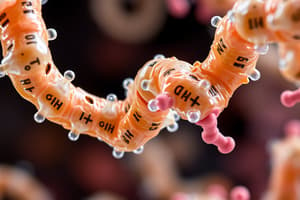Podcast
Questions and Answers
What type of DNA ends are produced when some endonucleases cut both strands of a DNA molecule at points directly opposite each other?
What type of DNA ends are produced when some endonucleases cut both strands of a DNA molecule at points directly opposite each other?
- Sticky ends
- Overhanging ends
- Blunt ends (correct)
- Single-stranded ends
Which enzyme is used to join DNA fragments with 'blunt ends' together?
Which enzyme is used to join DNA fragments with 'blunt ends' together?
- DNA helicase
- DNA ligase (correct)
- Endonuclease
- DNA polymerase
In 'blunt end' ligation, how are the DNA fragments joined together?
In 'blunt end' ligation, how are the DNA fragments joined together?
- Through the use of RNA ligase
- Through DNA polymerase activity
- Directly using DNA ligase (correct)
- With complementary base pairing
Which type of DNA ends allow for more control over the orientation of the resultant insertion?
Which type of DNA ends allow for more control over the orientation of the resultant insertion?
When identifying restriction sites, why is it important to consider the direction of the DNA strands?
When identifying restriction sites, why is it important to consider the direction of the DNA strands?
What is the main function of endonucleases in genetic engineering?
What is the main function of endonucleases in genetic engineering?
What determines how frequently a restriction enzyme cuts a random sequence of DNA?
What determines how frequently a restriction enzyme cuts a random sequence of DNA?
What is the significance of recognition sequences for restriction enzymes?
What is the significance of recognition sequences for restriction enzymes?
How do blunt ends and sticky ends differ in the context of DNA manipulation?
How do blunt ends and sticky ends differ in the context of DNA manipulation?
What is the role of DNA ligase in gene cloning procedures?
What is the role of DNA ligase in gene cloning procedures?
In the context of endonucleases, what do recognition sites refer to?
In the context of endonucleases, what do recognition sites refer to?
Why is it important for researchers to know the recognition sites of restriction enzymes?
Why is it important for researchers to know the recognition sites of restriction enzymes?
What is the significance of the symbol * in the recognition sequences of restriction enzymes?
What is the significance of the symbol * in the recognition sequences of restriction enzymes?
When adding EcoRI to a solution containing the specified double-stranded DNA, what is the expected outcome?
When adding EcoRI to a solution containing the specified double-stranded DNA, what is the expected outcome?
Which statement correctly describes DNA fragments resulting from HindIII digestion of a DNA molecule?
Which statement correctly describes DNA fragments resulting from HindIII digestion of a DNA molecule?
Which enzyme will cut the specified piece of DNA: 5’ C T T A A G C T T C C A A A T T A C C G A 3’?
Which enzyme will cut the specified piece of DNA: 5’ C T T A A G C T T C C A A A T T A C C G A 3’?
How do enzymes like EcoRI create sticky ends in DNA?
How do enzymes like EcoRI create sticky ends in DNA?
What is the function of DNA ligase in genetic engineering processes involving restriction enzymes?
What is the function of DNA ligase in genetic engineering processes involving restriction enzymes?
Flashcards are hidden until you start studying





